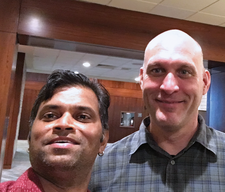An interview with Greg Kroah-Hartman
World Domination

© ©Swapnil Bhartiya
Greg Kroah-Hartman is one of the friendliest faces of the Linux kernel community. He maintains the stable branch of the Linux kernel and participates in many more Linux projects. He works at the Linux Foundation as a fellow, a job that allows him to dedicate his time to the Linux kernel. I sat down with Greg to talk about the kernel, 25 years of Linux, and what he does with the rest of his life.
Greg Kroah-Hartman is one of the friendliest faces of the Linux kernel community. He maintains the stable branch of the Linux kernel and participates in many more Linux projects. He works at the Linux Foundation as a fellow, a job that allows him to dedicate his time to the Linux kernel. We meet each other at almost every Linux-related conference. I sat down with Greg to talk about the kernel, 25 years of Linux, and what he does with the rest of his life.
Linux Magazine : What and how much has Linux achieved in these 25 years?
Greg Kroah-Hartman : We had this joke: "Total world domination was our goal." Everybody laughed at us. Then we did it, and nobody even noticed. I mean, we're everywhere. We're going places that Linux has never been. It's crazy to think that this project we all started working on for fun, myself included, has done this. It's insane.
[...]
Buy this article as PDF
(incl. VAT)
Buy Linux Magazine
Subscribe to our Linux Newsletters
Find Linux and Open Source Jobs
Subscribe to our ADMIN Newsletters
Support Our Work
Linux Magazine content is made possible with support from readers like you. Please consider contributing when you’ve found an article to be beneficial.

News
-
Mozilla Plans to AI-ify Firefox
With a new CEO in control, Mozilla is doubling down on a strategy of trust, all the while leaning into AI.
-
Gnome Says No to AI-Generated Extensions
If you're a developer wanting to create a new Gnome extension, you'd best set aside that AI code generator, because the extension team will have none of that.
-
Parrot OS Switches to KDE Plasma Desktop
Yet another distro is making the move to the KDE Plasma desktop.
-
TUXEDO Announces Gemini 17
TUXEDO Computers has released the fourth generation of its Gemini laptop with plenty of updates.
-
Two New Distros Adopt Enlightenment
MX Moksha and AV Linux 25 join ranks with Bodhi Linux and embrace the Enlightenment desktop.
-
Solus Linux 4.8 Removes Python 2
Solus Linux 4.8 has been released with the latest Linux kernel, updated desktops, and a key removal.
-
Zorin OS 18 Hits over a Million Downloads
If you doubt Linux isn't gaining popularity, you only have to look at Zorin OS's download numbers.
-
TUXEDO Computers Scraps Snapdragon X1E-Based Laptop
Due to issues with a Snapdragon CPU, TUXEDO Computers has cancelled its plans to release a laptop based on this elite hardware.
-
Debian Unleashes Debian Libre Live
Debian Libre Live keeps your machine free of proprietary software.
-
Valve Announces Pending Release of Steam Machine
Shout it to the heavens: Steam Machine, powered by Linux, is set to arrive in 2026.

